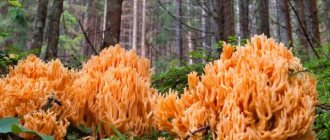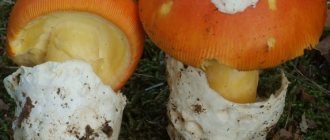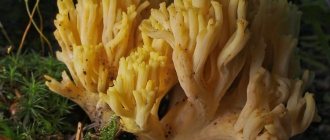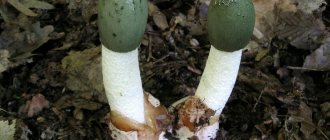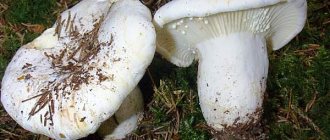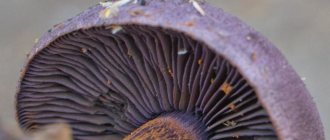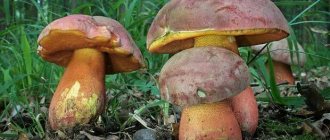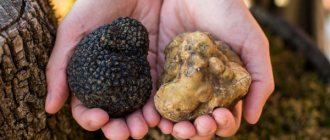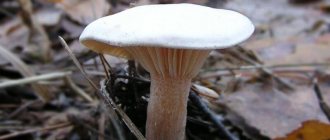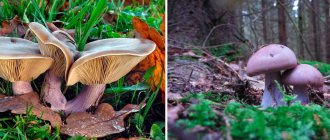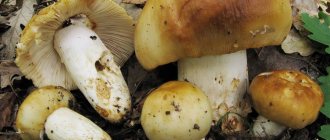Sarcosoma globosum
Rare and outlandish jelly-like mushrooms grew in the forest of the Lomonosov region. Sarcosoma globulus was met there by photographer Tatyana Liverovskaya. She spoke about this on her page on the VKontakte social network.
Sarcosoma is considered inedible, but is used in traditional treatment.
The mushroom was actively used in folk medicine as a treatment for rheumatism, any pain in the joints and a means of rejuvenation (used externally), for which it is also called the “rejuvenating apple.”
Tatiana Liverovskaya, photo author
There were quite a lot of mushrooms: more than ten large ones, up to 8 cm in diameter and the size of a fist, with several small ones nearby. Sarcosoma usually grows in the spring, when the snow melts, but due to the warm winter, it grew much earlier this year.
Sarcosoma globose
This fantastic mushroom changes its appearance several times throughout its life, and each time it represents something special, alien.
Sarcosoma globulus still remains a mystery to many, although scientists have been studying this fungus for decades. Sarcosoma globosum - lat.Sarcosoma globosum
The fungus is also called Bulgarian globulus.
Description of the mushroom
External characteristics
The height of the mushroom reaches 50-100 mm, diameter - 30-80 mm. Bulgarian globulus goes through several stages of development: at the first it resembles a soft ball, at the second it becomes like an onion or a cone-shaped figure with a neck. The third stage involves the “loss of weight” of the fungus and the “turning” of the spore-bearing layer outward with the formation of another hole in the central part of the fruiting body, necessary for the release of liquid.
The surface of the mushroom, which does not have a leg, resembles suede. In youth it is smoothed, closer to old age it is folded. It has a brown or brown color, darkening towards the base.
In the center of the fruiting bodies, a hymenium is formed in the form of jelly or skin of a charcoal gray, almost black hue. Underneath it lies mucus, or, as it is simply called, “earth oil,” which emits a pleasant mushroom smell.
Elongated spores form in cylindrical bags.
The life of a mushroom lasts about two months, but often mushrooms, swollen with liquid, burst and die much earlier.
Places of growth
Being a saprophyte, Sarcosoma globulus prefers mossy places and fallen needles in pine and spruce forests. It grows in Russian regions with temperate climates and European countries, and is quite rare, since it bears fruit in eight to ten years. On Siberian soil, fruiting is more frequent.
The mushroom bears fruit in groups, sometimes 2-3 pieces grow together. The harvest is harvested in early spring, until the end of May.
Edibility
Some sources claim that this sarcosome is not suitable for consumption, while others refer to it as a conditionally edible mushroom.
Despite its unappetizing appearance, some mushroom pickers are happy to prepare “sarcosomnik” from it, fry it and stew it with potatoes. But most lovers of quiet hunting are only surprised by the appearance of the mushroom and pass by.
Medicinal properties of Sarcosome globulus
Some people eat unusual mushrooms, others use them to get rid of various ailments.
The mushroom contains eighteen fatty acids, including stearic, palmitic and heptodecanic, a special pigment (like chaga), as well as many amino acids in the form of glycine, lysine, cysteine, arginine, etc. Thanks to such a useful composition, this sarcosome has the following healing properties:
- Improved brain activity. To do this, “earth oil” is taken daily on an empty stomach.
- Increased body tone. Jelly-like mucus strengthens the immune system, rejuvenates the body, calms the nervous system and restores strength after fatigue.
- Treatment of stomach diseases. The mushroom helps treat gastritis and other stomach diseases.
- Strengthening hair follicles. Mushroom liquid nourishes the hair follicles and accelerates hair regrowth. It is rubbed into the scalp.
- Skin rejuvenation. The walls of the fruiting body are crushed and used as a mask for skin rejuvenation.
- Treatment of joints. Rubbing an alcohol tincture into the walls of fruiting bodies helps with polyarthritis, rheumatism and other joint diseases.
Some sources claim that Sarcosoma globulus in the form of intramuscular injections of its juice is used in the treatment of cancer.
Sarcosoma globular - description of where it grows, toxicity of the fungus
Having noticed a globular sarcosoma in the forest, an inexperienced mushroom picker most likely will not understand that there is a mushroom representative under his feet, although it is so rare that any mycologist will envy him that he is lucky to see it.
Unique mushroom without stem
Sarcosoma globulus is admired even by scientists, it is so unusual, and although it is considered inedible, it brings invaluable benefits to people.
Belongs to the ascomycete representatives of the Sarcosome family. It also has another name - spherical bulgaria.
The fruiting body of the mushroom itself is quite large and, as the name confirms, spherical, but sometimes in the shape of a bulb or cone. A young specimen may have a cylindrical shape. The height of the mushroom can reach from 3 to 9.5 cm, and its diameter ranges from 3 to 8 cm.
The upper part is saucer-shaped, and at the top, in the very middle of the body, is the hymenium, which has a black-brown or completely dark shade and is a jelly-like or so-called leathery film. The hymenium is slightly pressed inward to preserve the contents of the mushroom.
Externally, the spherical sarcosoma is very similar to a pot-bellied small barrel with a neck, which is filled with a clear, light liquid. Looks like a fairy-tale hero from a magical forest. The color of the fruiting body is often brown or dark brown, but in the lower part it is always a darker shade.
The fruit body has a soft consistency, the skin is soft, smooth and velvety. The surface is uneven. May be moderately wrinkled or completely wrinkled in older specimens. At the base, large hyphae are visible - rhizomorphs, which stretch only a few centimeters.
Why the mushroom needed this watery consistency, scientists are still arguing. It was once thought that it was spore-bearing, but it turned out that the formation of spores occurs in the asci (they have the shape of cylinders). They are located on a surface resembling a lid. It is assumed that when the fungus reaches a certain age, the liquid penetrates the bags. Because of this, they are torn, and the spores end up outside. There is also an opinion that the sarcosome needs this liquid as nutrition and to increase its size, so that unnecessary forces are not wasted to add mass.
The scattered spores then begin to germinate, but can quickly die if the conditions are not right.
Mushrooms usually live no more than 60 days. When they swell, they burst quite quickly, and this is the most compelling reason why it is rare to find a mushroom that has lived to old age.
During his life, he undergoes amazing changes, many of his secrets have not been fully solved, so he always attracts the attention of scientists
Places of distribution
The favorite habitat of the mushroom is coniferous forests. There is always a lot of fallen needles and an abundance of moss - the most attractive conditions for globular sarcosoma. Since, in fact, these are saprophytes, they are always found in dense grass, and therefore it is difficult to find mushrooms. But, if one is found, it means that there may be 8-10 more nearby. They grow singly, but they can also grow together.
It is believed that if you need a bountiful harvest of mushrooms, it can only be collected once every 8 to 10 years. It is collected at the end of April and May. In areas of Siberia, these mushrooms can be found immediately after the snow cover has melted. They grow in Europe, and also have, as is known, an Arctic-Alpine distribution.
This mushroom is listed in various regions of Russia in the Red Book. Due to its uniqueness, globose sarcosoma is not similar to any other species, so it is impossible to confuse it with another mushroom.
Healing properties and medical uses
Traditional healers use this mushroom. They are especially attracted to their liquid. As it turned out, it is rich in valuable substances - amino acids, as well as fatty acids beneficial to the human body. Excellent healing agents for treating radiculitis and relieving nervous tension are obtained from earthen oil. Many healers are confident that the mushroom has a fast-acting anti-aging effect and helps accelerate hair growth, which is why it is actively used by cosmetologists. Ointments and tinctures, as well as effective decoctions and masks, are prepared from this mushroom.
It is believed that sarcosome globulus can fight cancer cells and stimulate brain activity.
Distribution and fruiting period
Globular sarcosoma usually grows in coniferous forests - spruce and pine forests, choosing those places where there is moss and pine litter. She is a saprophyte and likes to hide in the forest floor and grass, which makes it difficult to collect. It usually grows in colonies of 8-10 pieces, some fruiting bodies can grow together.
Interestingly, there is an opinion that a bountiful harvest of sarcosomes can be harvested only once every 8-10 years. However, mushroom pickers who know the places where these mushrooms grow find them every year. Sarcosoma is listed in the Red Books of certain regions of Russia.
The fruiting period begins early - sarcosomes are collected at the end of April and in May, immediately after the snow cover melts or even during the melting of the snow. The mushroom grows in Europe, in Russia it is found in the Leningrad region, Moscow region, in Siberia, and has an Arctic-Alpine distribution.
Interesting facts about the mushroom
- According to some scientists, sarcosome globulus is capable of fighting cancer cells.
- In some sources, sarcosome is classified as an inedible species of mushroom. But in some regions of Russia it is fried or stewed with potatoes. The dish is called “sarcosomnik”.
- It is believed that a rich harvest of cam can be harvested no more often. than once every 8-10 years. It is with this frequency that the fungus releases fruiting bodies.
- Earth oil has a unique composition that allows you to treat a wide variety of diseases, even cancer.
Sarcosoma is a mushroom that is not only rare in prevalence, but also extremely useful. Without knowing what it is and how it should be used, you can pass it by without risking putting it in your cart. Having an idea of its unique composition and properties, you hardly want to miss the chance to improve your health with the help of such a magnificent gift of nature.
Marsupial fungi - Ascomycetes
Family Sarcosomaceae - Sarcosomataceae
Sarcosoma globose
Sarcosoma globosum (Schmidel) Rehm Category and status. 2a - a species that is declining in number as a result of changes in living conditions and destruction of habitats. A brief description of. The fruiting bodies develop in groups, at first almost spherical, later barrel-shaped, gelatinous, 3-12 cm in diameter, wrinkled on the outside, dark brown, with a black-brown, shiny, flat or slightly concave disk. The pulp is thick, almost colorless, gelatinous (1). Breaks in fruiting can last up to 10 years. April May.
Spreading. In Russia: Komi Republic (2), Tatarstan (3), Udmurt Republic (4), Khanty-Mansi Autonomous Okrug (5), Krasnoyarsk Territory (6), Astrakhan (7), Kaliningrad (8), Kirov (9), Leningrad (10), Moscow (11), Novosibirsk (12), Pskov (15), Sverdlovsk (16), Tambov (17) regions, Perm region (13, 14). General distribution: outside Russia it is found in Central and Northern Europe, Transcaucasia, and eastern North America (18-20). Features of ecology and phytocenology. Saprotroph. It is found on the soil in spruce and mixed with spruce, less often in pine forests.
Number. Not known.
State of local populations. Not researched.
Limiting factors. Not known.
Security measures taken. Included in the Red Books of the Komi Republic (2), Udmurt Republic (4), Khanty-Mansiysk Autonomous Okrug (5), Astrakhan (7), Kirov (9), Tambov (17) regions. , Middle Urals (Sverdlovsk and Perm regions) (14, 16), nature of the Leningrad region. (10). Protected in the Yugansky Nature Reserve (21).
Necessary security measures. Conservation of species habitats.
Cultivation possibilities. Not studied.
Information sources. 1. Garibova, Sidorova, 1997; 2. Red Book of the Komi Republic, 1998; 3. Vasilyeva, 1977; 4. Red Book of the Udmurt Republic, 2001; 5. Red Book of the Khanty-Mansiysk Autonomous Okrug, 2003; 6. Vasina, 2006; 7. Red Book of the Astrakhan Region, 2004; 8. Dedkov et al., 2007; 9. Red Book of the Kirov Region, 2001; 10. Red Book of Nature of the Leningrad Region, 2000; 11. Gorlenko et al., 1989; 12. Perova, Gorbunova, 2001; 13. Syuzev, 1914; 14. About the list..., 2001; 15. Compiler's data; 16. Red Book of the Middle Urals, 1996; 17. Red Book of the Tambov Region, 2002; 18. Dahlberg, Croneborg, 2006; 19. Nanagulyan, 2005; 20. Seaver, 1961; 21. Zvyagina et al., 2007. Compiled by: E.S. Popov.
AOF | 01.12.2014 23:03:31
Description of the fungus sarcosome globular
Among the variety of mushrooms, there are those that are used for medicinal purposes. One of them is the sarcosoma globulus fungus.
Botanical characteristics
Sarcosoma globulus is classified as a marsupial (ascomycetes), which has septate mycelium and specific sporulation organs in the form of bags called asci. The mushroom stem is missing.
The fruiting body, called the apothecium, initially has the shape of a ball, and over time it takes on the appearance of a bulb. As an individual specimen matures, wrinkled folds appear on the surface of the fruiting body; it becomes soft in structure and bag-like in shape, maintaining the velvety quality of the outer layer.
The color is dark brown or dark brown. The diameter of the fruiting body is 6-8 cm. Height is 5-10 cm. The surface has a velvety coating.
According to its external description, it looks like a barrel with a lid filled with liquid.
Sarcosoma is poisonous, conditionally edible. They are saprophytes and live on the dead remains of living things.
Geography of distribution
Arctic-alpine distribution. Rarely found in areas of Central Europe. Preferred habitats are coniferous forests. Can be found in layers of moss or in fallen pine needles.
Mass appearance is rarely observed - once every 3-4 years. Life expectancy is no more than 2 months.
Grows in small groups of 8-10 pieces. The largest number of accumulations is in the Siberian taiga. The species is rare and is included under the protection of the Moscow, Kirov, Tyumen, Arkhangelsk regions and is on the Red Book of Tatarstan.
Practical use
The conditionally edible mushroom is used to prepare potato stews called sarcosomics.
The main reason is its medicinal properties. The internal oil contains earthen oil, a gelatinous jelly-like mass that includes fatty acids (palmitic, stearic, heptodecanic) and a number of amino acids (including cysteine, lysine, glycine, valine, etc.). Thanks to this mono, the following healing properties can be identified:
- has biostimulating qualities that have a rejuvenating effect on the body, increases the efficiency of the immune system, and imparts vitality;
- External use of mushroom tinctures allows you to relieve pain symptoms from rheumatism, polyarthritis and other joint diseases;
- sarcosome infusion drunk on an empty stomach
- crushed walls of the mushroom are used as anti-aging masks for the face and body, strengthens hair follicles, acting as an effective remedy against hair loss;
Recently, traditional medicine has been widely exploring the positive effects on the body of intramuscular injections with mushroom extract in the fight against cancer.
Description
Sarcosoma globose is a saprophyte ascomycete in the shape of a ball or barrel.
Sarcosoma is spherical.
Fruiting body
It is not divided into a cap and a stem. At a young age, the mushroom looks like a ball, and as it matures it takes on the shape of a bulb. The size reaches 6–8 cm in diameter, and up to 10 cm in height. The color is dark brown. The outer surface is dry, velvety and wrinkled. The total weight (including the hymenium) is about 220 g.
This mushroom does not have any pulp as such. The entire fruiting body is represented only by the shell and hymenium, which is covered on top by a leathery “lid”. As it dries, the fruiting body becomes flattened.
Spore-bearing layer
Bulgarian globulus.
Represented by the hymenium. It is located inside the “barrel” of the fruiting body. It has a shiny surface and gel consistency. The color of the hymenium is black.
It is believed that the hymenium is located only on the surface of this “jelly” (in the “lid”), and everything else is a backup power source. Popularly this substance is called “earth oil”. It has no taste, but has a pleasant mushroom smell.
Spore powder
The spores of this species are very large, ovoid, colorless. The spore powder is also not colored.
Sarcosoma globose: what does the rarest mushroom look like?
Sarcosoma globulus is a representative of the genus Sarcosoma, family Sarcosomaceae. This mushroom is also called Bulgarian globulus. This is an inedible mushroom.
The Latin name of the mushroom is Sarcosoma globosum.
Description of the sarcosome globular.
The fruiting body of Sarcosoma globulus is large, 3-9.5 centimeters high, and its girth can be 3-6 centimeters. The weight of the mushroom ranges from 20 to 220 grams, including liquid.
The shape of young mushrooms is cylindrical or spherical, with the upper part being saucer-shaped. The hymenium is located at the top. That is, in appearance the mushroom resembles a barrel with a lid filled with a light transparent liquid.
The surface of the fruit body is uneven, wrinkled or slightly wrinkled. The color of the fruiting body is brown or dark brown, and the hymenium is black-brown. At the base of the fungus there are large hyphae called rhizomorphs. They stretch several centimeters. The spores are colorless.
When wet, the spherical sarcosoma is filled with a colorless, watery-gelatinous mass, the consistency of which resembles gelatin. When dry, the mushroom becomes flat. The pulp hyphae are embedded in the gelatinous pulp.
Places of growth of sarcosome globulus.
This is a saprotrophic ascomycete fungus. Globular sarcosomes grow on the soil; they hide in spruce and moss litter. These mushrooms can be found in spruce-fir, cedar-fir and dark coniferous forests. Most often they grow together in groups of 8-10 pieces.
Most of the fungus is almost completely hidden in the moss, and only the upper part is visible from the outside. Sarcosomes spherical grow in the Perm and Pskov regions of Western Siberia. They are also common in Europe and North America. They bear fruit from April to May.
In Europe, the number of these mushrooms is falling. Sarcosomes spherical were found in the south of the Leningrad region. They were also found on the Karelian Isthmus.
Number of sarcosomas globose.
Sarcosoma globulus is a rare mushroom listed in the Red Book of Russia. In some years they can be quite abundant in Western Siberia, but most often they are very rare. Globular sarcosomes appear en masse once every 8-10 years.
The development of new territories and deforestation have made these mushrooms almost impossible to find in nature. Any new places are recorded and marked on the map.
Reproduction of sarcos globose.
The liquid of the mushroom contains sugars, with their help creating pressure inside the apothecia, which promotes the ejection of mature spores. Spores are released every 3 minutes with high pressure. As the liquid is ejected, its amount decreases, and the mushroom becomes wrinkled, looking like a black plate.
Globular sarcosomes bear fruit in the spring, sometimes even from under the snow. Scattered spores germinate, but die immediately, since they need special conditions to grow. These mushrooms can only grow on moss litter, and they must be located far from civilization.
If a spore penetrates deep into the moss, it develops under favorable conditions, and a new mushroom grows after a few years. Spores can be stored for years and even decades, which is why periodic growth is noted. Finding these rare mushrooms is also difficult because they are perfectly camouflaged among the moss.
Medicinal properties of globose sarcosomas.
These mushrooms are used in folk medicine as a remedy for rheumatism. The inner mass of the mushroom is rubbed on the lower back. The liquid of sarcosome globulus contains sugars, for which it is highly valued and used as a medicine. This liquid contains 18 fatty acids. This liquid helps boost immunity. If you rub it into the scalp, it accelerates hair growth.
Nourishing masks for the skin are made from the walls of the mushroom. Alcohol tinctures are made from them. The preparation “Earth oil” is prepared from sarcosome globulus. This is not just a cosmetic product, but also a cure for many diseases.
Scientists have not fully discovered all the medicinal potential of sarcosome globulus. The liquid and walls of this mushroom contain very rare proteins that cannot be synthesized artificially.
Interesting Facts
Bulgarian globulus.
Sarcosoma globulus has found application in folk medicine thanks to its “gel” component.
This substance contains a lot of valuable amino acids that are considered useful for:
- Rejuvenation.
- Treatment of rheumatism.
- Treatment of diseases of the nervous system.
- Enhance immunity.
- Brain stimulation.
- Improved condition of skin, hair and nails.
- Prevention of tumor diseases.
So, despite its unpresentable appearance, globular sarcosome can be used for both nutrition and treatment. However, its properties have not yet been fully studied.
Places of growth of sarcosome globulus.
This is a saprotrophic ascomycete fungus. Globular sarcosomes grow on the soil; they hide in spruce and moss litter. These mushrooms can be found in spruce-fir, cedar-fir and dark coniferous forests. Most often they grow together in groups of 8-10 pieces.
Most of the fungus is almost completely hidden in the moss, and only the upper part is visible from the outside. Sarcosomes spherical grow in the Perm and Pskov regions of Western Siberia. They are also common in Europe and North America. They bear fruit from April to May.
In Europe, the number of these mushrooms is falling. Sarcosomes spherical were found in the south of the Leningrad region. They were also found on the Karelian Isthmus.
This is an inedible species and is not used as food.
Number of sarcosomas globose.
Sarcosoma globulus is a rare mushroom listed in the Red Book of Russia. In some years they can be quite abundant in Western Siberia, but most often they are very rare. Globular sarcosomes appear en masse once every 8-10 years.
The development of new territories and deforestation have made these mushrooms almost impossible to find in nature. Any new places are recorded and marked on the map.
Reproduction of sarcos globose.
The liquid of the mushroom contains sugars, with their help creating pressure inside the apothecia, which promotes the ejection of mature spores. Spores are released every 3 minutes with high pressure. As the liquid is ejected, its amount decreases, and the mushroom becomes wrinkled, looking like a black plate.
Globular sarcosomes bear fruit in the spring, sometimes even from under the snow. Scattered spores germinate, but die immediately, since they need special conditions to grow. These mushrooms can only grow on moss litter, and they must be located far from civilization.
If a spore penetrates deep into the moss, it develops under favorable conditions, and a new mushroom grows after a few years. Spores can be stored for years and even decades, which is why periodic growth is noted. Finding these rare mushrooms is also difficult because they are perfectly camouflaged among the moss.
Spreading
Sarcosoma globosum.
Sarcosoma globulus is not a very widespread species. It grows in some northwestern regions of Russia (Pskov and Leningrad regions, Karelia), in the Urals (Perm region), in Western Siberia, and is found in some European countries and North America.
In some areas it can be found in large groups (up to 10 pieces). Many sources claim that fruiting in this species is not observed every year, but once every 8 years at least. Sarcosoma globulus prefers to grow in moss on a coniferous substrate.
Mushrooms appear when the snow melts in the spring; such an specimen lives for about 2 months (often even less, since the fruiting bodies are easily deformed and burst).
Medicinal mushroom Sarcosoma globosum
During the Yaran “epic” in May last year, I had the opportunity to meet an unusual, rare (listed in the Red Book of the Kirov region), but at the same time considered very healing (almost a panacea for all diseases) mushroom - Sarcosoma globosum ), popularly called “earth oil”.
Sarcosoma fruiting bodies appear very early in the spring, even before the appearance of morels and strings. Sometimes there is still snow around, and these small “barrels” grow on patches of thawed earth.
The fruiting body of young mushrooms is buried in moss, 5-10 cm high and 3-7 cm in diameter, barrel-shaped, dark brown or dark brown in color. As the mushroom grows, folds form on the body of the mushroom, it becomes softer and bag-like, velvety on the outside. Found in small groups of 8-10 pieces.
Sarcosoma globulus is a very rare mushroom; it is listed in the Red Book of both the Kirov region and other regions. It is believed (although this may be just a misconception) that the mass appearance of sarcosome fruiting bodies occurs very rarely. According to various sources, this can happen once every 3 years, and even once every 8-10 years. In other years it almost never occurs.
The mushroom looks like a barrel with a lid, filled inside with a transparent light liquid, which is popularly called “earth oil,” just like the mushroom itself. It is believed to have medicinal properties. This gelatinous jelly-like mass contains 18 fatty acids and a number of amino acids - glycine, cysteine, valine, histidine, lysine. It is considered a good biostimulant, can have a rejuvenating effect on the body, relieves nervous tension, and is used as a remedy against rheumatism. Some endow it with absolutely fantastic properties - even treating oncology with the help of intramuscular injections.
I tried this liquid - nothing special. A liquid and slightly slimy substance with a faint mushroom odor and without any distinct taste. There were no immediate consequences for me with such a small dose.
In the vast expanses of the Siberian taiga, in some places this mushroom is very common, and, contrary to the instructions of most reference books, it is quite edible. Young mushrooms are stewed there together with potatoes in their own juice, resulting in a specific, but very tasty dish - sarcosomnik. Igor Krom writes about this in detail in his report.
Here I have not very good photos - I was too lazy to unhook the tripod, and there was little light in the forest. I advise you to look at Sergei Talanov’s blog for more successful pictures.

